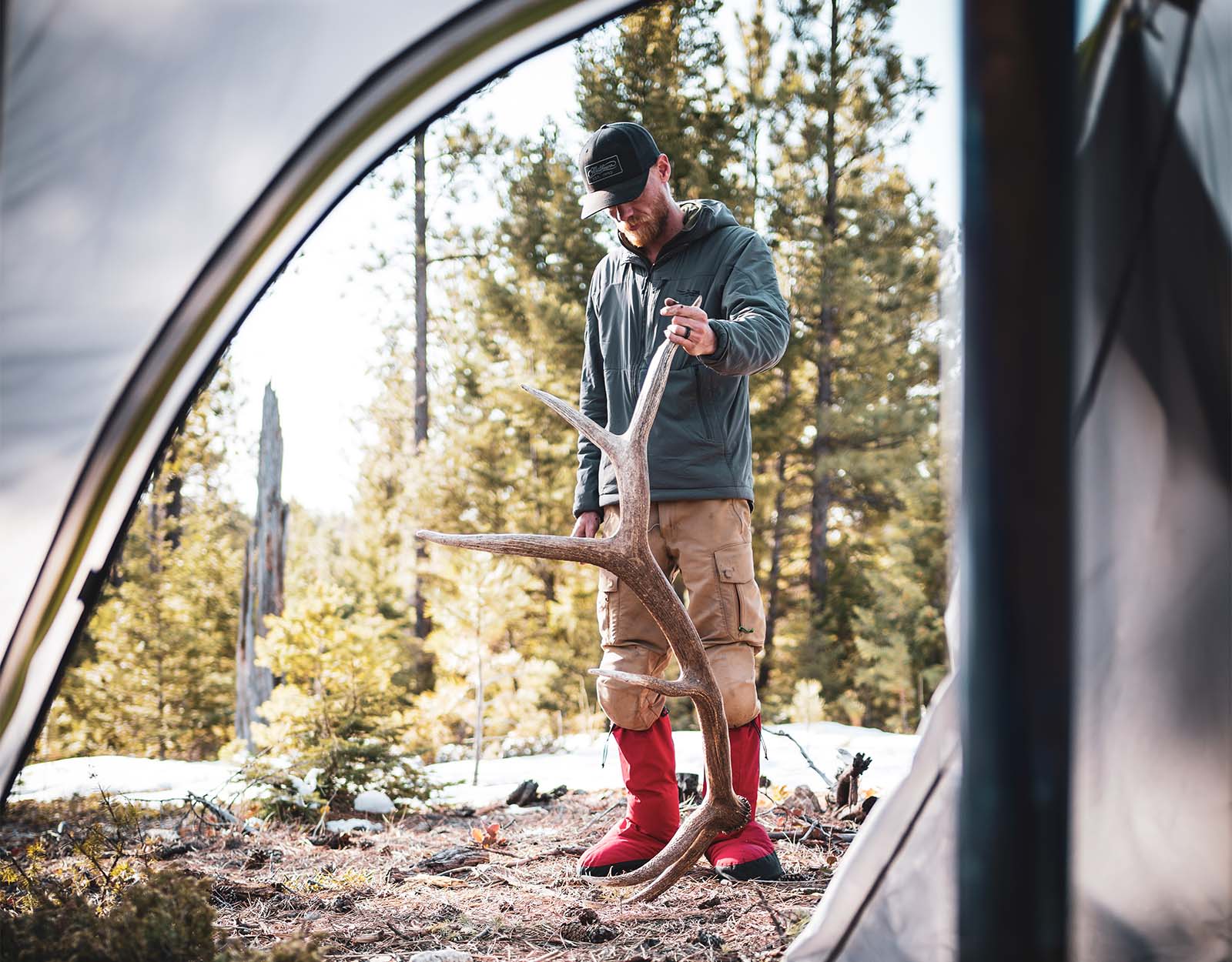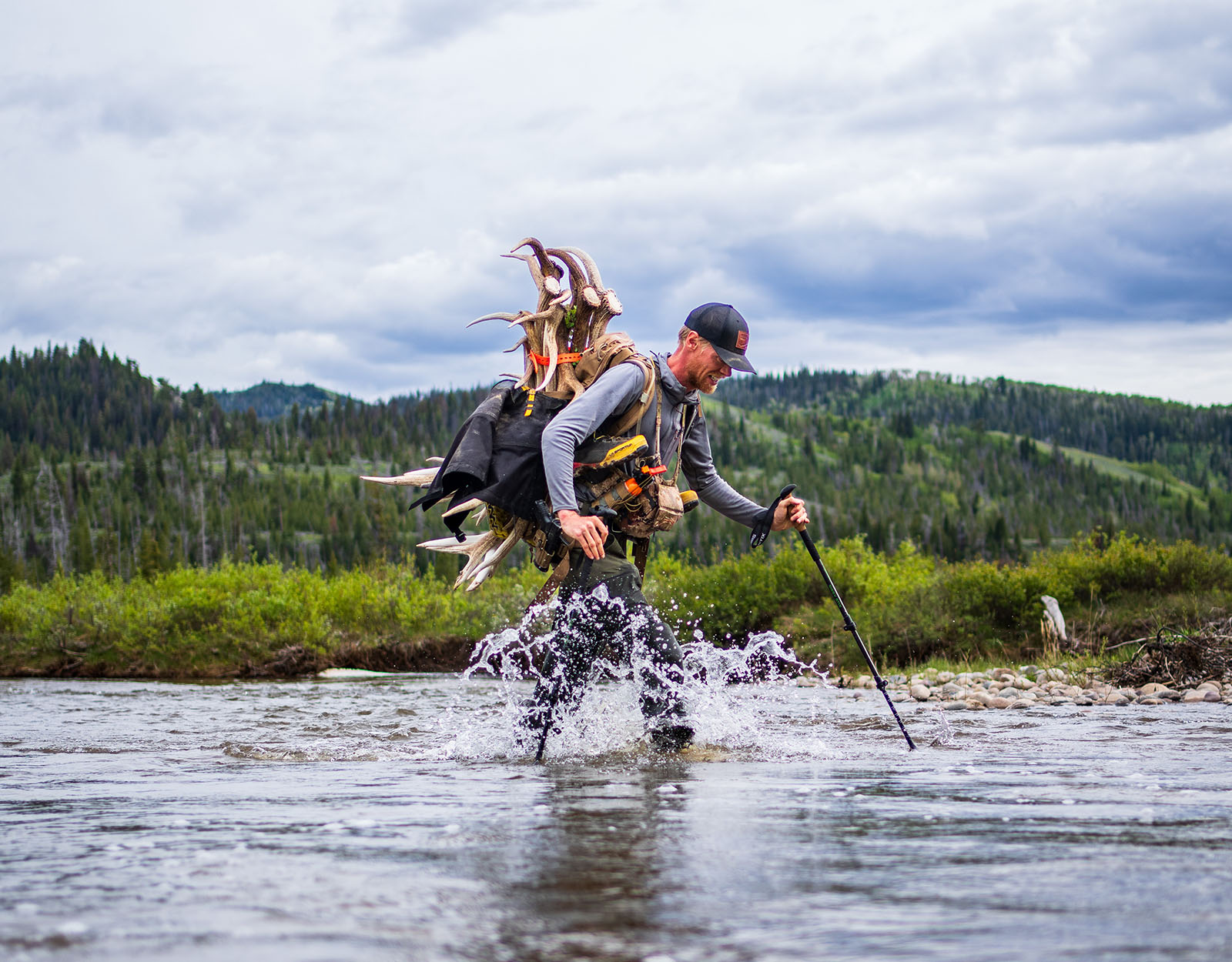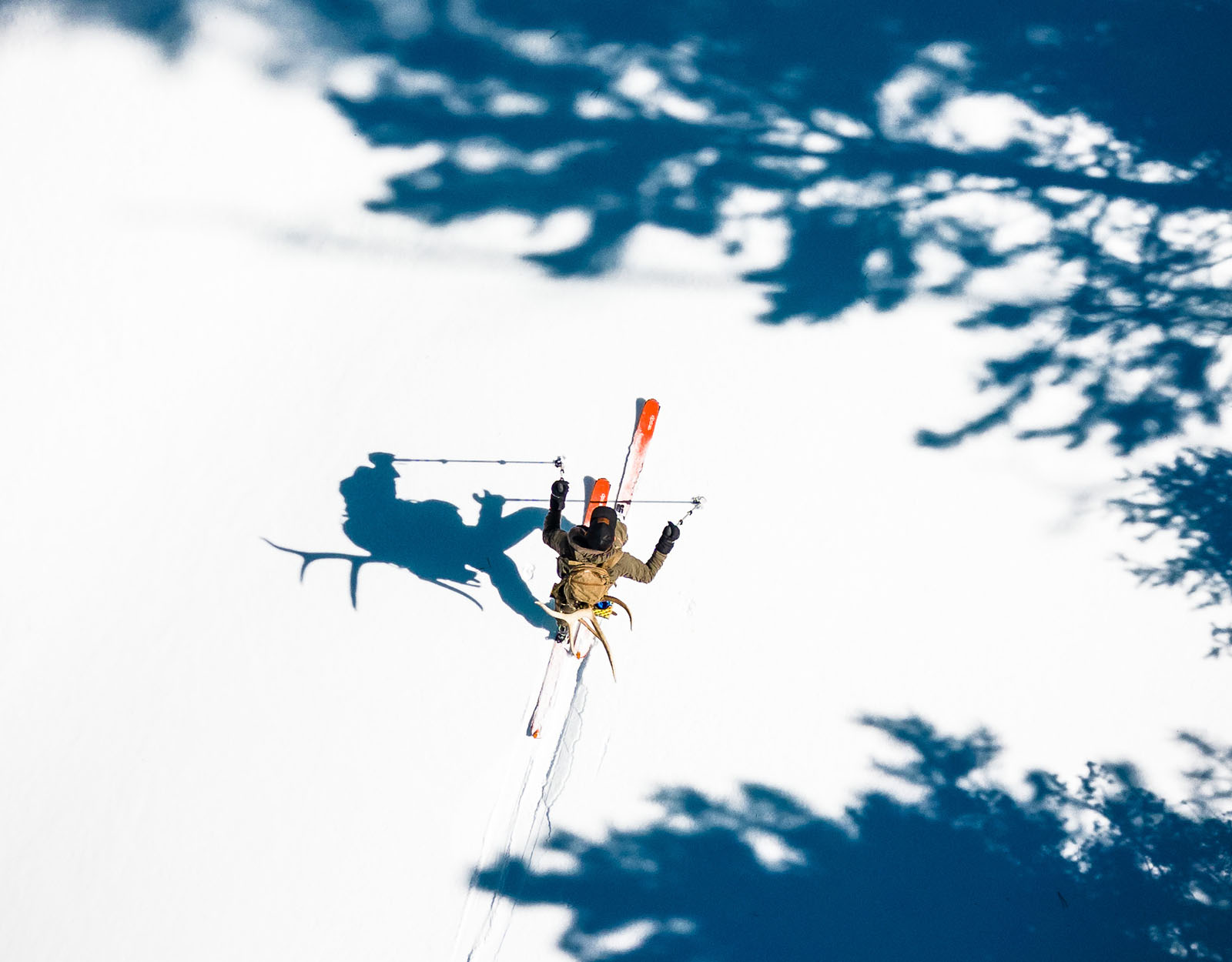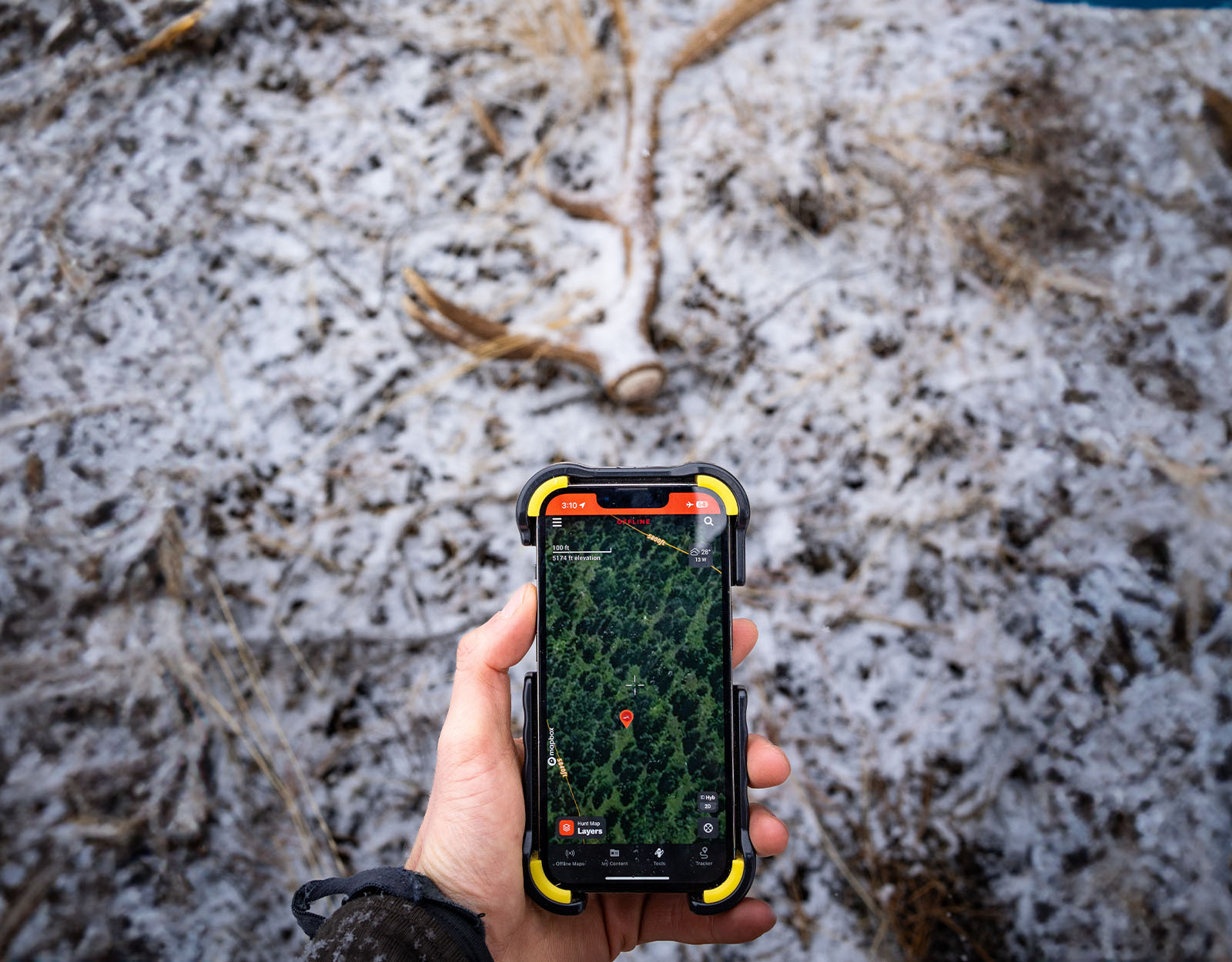Professional hunting photographer and onX Ambassador Steven Drake spends 30+ spring days crawling the mountains of the West hunting for sheds. That dedication made him the perfect expert to talk about shed hunting in our latest masterclass, Shed Hunting With Steven Drake.
While Steven shares many of his tips and tricks in the class itself, we asked him to talk a bit about his process in his own words. Shed hunting may seem like a fairly straightforward hike with random antler finds, but there’s certainly a method to the madness. We asked Drake to share a few of his top tips to find success when shed hunting.
And so, from Steven Drake:
Searching for elk sheds in the springtime is a great opportunity to get outside after a long winter, get in shape, and continue your 365-day/year hunting pursuit.

Spring Shed Hunting Doubles as Fall Scouting
In addition to finding antlers while shed hunting, I’m able to learn new hunting areas and identify the type and quality of game animals that live in certain zones. This information transfers over extremely well to fall hunting seasons. Many of the game animals I’ve harvested in the fall have been a result of what I’ve learned during spring shed season.
Shed season is my favorite season. It cures any winter cabin fever and allows me to continue the year-round pursuit of learning about animals and wild places. Through shed hunting, I’m able to learn new areas and potentially find the byproducts of game animals that I never knew existed. Each winter, I spend a dozen days scouting winter ranges for bulls. Then, come spring, I log 30 or more days looking for sheds. The hiking mileage is immense, but the knowledge and experience gained have a direct correlation to the success I’ve found on fall hunts. The learning curve of shed hunting is steep, but over the years I’ve discovered some tactics that have helped me in the field.
Where To Shed Hunt
Every hunting unit that has elk will have shed hunting opportunities—and most of the western states have thousands of elk. Let’s use Colorado as an example. Colorado has ~250,000 elk in the state. Roughly 25% of that population are bulls, which means there are ~62,000 bull elk in Colorado. Every bull has two antlers, so that equates to roughly 124,000 fresh elk sheds each year in Colorado.

Now, as far as where to look for sheds, you need to focus your efforts where the bull elk spent their winter and spring. I’ll often go out in the middle of winter on cold, clear days and scout for bulls. Often in the dead of winter, bulls can be found on south-facing, wind-swept ridges with lots of feed. A good general rule when scouting in the winter and when shed hunting in the spring is that the bulls are usually in bachelor groups and at a higher elevation than cow elk, so if you’re finding cow elk, look higher! When I do locate a group of bulls, I’ll mark their location on the onX Hunt App, then use that as a starting point to begin my search in April and May.
All public lands are open for shed hunting. Note, though, that some states have shed hunting seasons and certain restrictions to reduce wildlife harassment and pressure. Before you go shed hunting, refer to your state’s regulations.
When To Shed Hunt
Elk shed their antlers when their testosterone is at its lowest point. The best months to find elk sheds are April and May. It’s tempting to go in early in hopes that a bull may have dropped early, but be patient and watch from afar until antlers are on the ground and you don’t run the risk of pressuring elk during their weakest months and running bulls into the next county.
What To Bring Shed Hunting
Shed hunting for elk antlers in the western states will likely mean you’ll be hiking from sun-up to sun-down and putting in many miles. It’s not uncommon to hike 20 miles in a day. Outside of my everyday carry items, some important pieces of gear I like to bring on a shed hunt include:
- Day Pack: A large day pack, or multi-day pack if you’re doing backpack shed hunts, with decent framing to support a load of antlers as well as a good strapping configuration to easily attach antlers to the pack. My go-to shed hunting pack is the Mystery Ranch Metcalf.
- Electrical Tape or Straps: If you are fortunate enough to find multiple antlers, the best way to strap them to your pack is to first strap the antlers together with either electrical tape or a Titan Strap, then attach the load to your pack. Instead of having multiple awkwardly shaped and weighted antlers strapped on, you’ll have one awkward but secure load of antlers.

- Binoculars and/or a Spotter: At a distance, it can be difficult to decipher if the elk you’re looking at is a bull or a cow elk and, if it is a bull, whether or not it has antlers attached. Binoculars mounted to a tripod are mandatory, and a spotting scope can be helpful.
- Bear Spray, If Applicable: If you’re shed hunting in grizzly bear country, it’s important to carry bear spray and have it readily accessible at all times. I attach mine to my binocular harness. It’s very accessible there and, compared to having it attached to your backpack, if I remove my pack or decide to grid search an area without my pack, I still have my bear spray with me.
- Pest Protection: Ticks can be rampant in the spring. To reduce tick bites and the potential transmission of tick-borne illnesses, I treat all my shed hunting clothes and gear with Permethrin Spray from Sawyer. Permethrin is a low-grade insecticide that kills ticks. I also wear gaiters and tuck my shirt into my pants to help prevent them from getting on me.
- onX Hunt App and Charger: I always bring my iPhone with the onX Hunt App, a USB battery brick, and an iPhone charging cable. I do all my e-scouting and navigating with the onX Hunt App. One feature that’s especially useful for shed hunting is the “Tracker” feature. When you start your shed hunt, open up the App. From the home screen on the bottom right, click “Tracker.” Then, press “Start.” Not only does the Tracker keep track of how far you’ve hiked, but it also allows you to see exactly where you’ve hiked, which is super helpful when you’re into a good shed zone and you want to grid search an area and not leave any stone unturned.
What To Expect
Depending on the state and region, April and May can be the wettest months of the year, so pack and plan accordingly.

Winter Scouting
As the temps drop and the snow gets deep, elk will move to big, south-facing, windswept slopes where grasses and shrubs get exposed. They’ll spend the winters in these areas as there’s ample food. As soon as fall hunting season ends, I start glassing winter range zones for bulls, and then keep tabs on these groups of bachelor bulls and focus on these zones come shed season in April / May. It’s obvious, but to find sheds, you’ve got to hike where the bull elk are.
Shed Hunting Tips
Bulls Don’t Mix With Cows: Generally, the fall rut is the only time mature bull elk will mix with cow elk. Outside that time period, the bulls will be in bachelor groups often positioned at a higher elevation than the cows. So, if you’re finding cow elk during the winter or shed season, look higher for the bulls. Also, bulls appear more yellow in color while cows are more brown.
Follow the Snow Line: As soon as the snow starts to melt and weather improves, the bulls will follow the snow line up towards their summering ground. The “drop” happens over the course of about six weeks, so as weather improves, following the snow line can lead to antlers.

Grid Search: While following the snow line, I focus most of my efforts on bedding and feeding areas—and everywhere in between—as that’s where elk spend the most time. Bedding areas tend to be thick, north-facing slopes full of blowdown, which can be quite challenging to find sheds in. If I find an antler in a zone like this, I’ll grid search the area for hours. The best way to do that is by using the onX Hunt Tracker feature. Simply turn tracking on, and you can see the exact route you walked so you can be sure to leave no stone unturned—and no shed left behind.
Just Keep Hiking: The more miles you put in, the more sheds you’ll find. When I started shed hunting, I averaged one shed per 10 miles of hiking. There definitely seems to be a direct relationship between miles hiked and sheds found, so if you’re not finding any, just keep hiking. My ratio has improved over the years as a result of the previously mentioned learnings, but if you’re getting disheartened or skunked, just keep hiking.
Remember that the learning curve is steep and competition is fierce.
For a deeper dive into shed hunting, check out Steve’s Masterclass exclusively for Elite Members. And if you’re not an Elite Member, sign up here. In addition to Steve’s Shed Hunting Masterclass, you’ll also get access to hunting maps for all 50 states and Canada and exclusive discounts to many of our favorite brands.